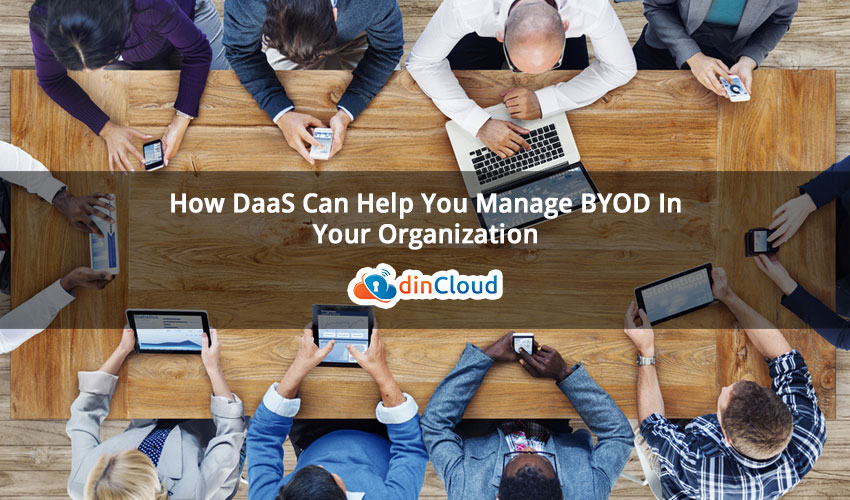A new category of cloud service providers has surfaced, supplying virtualized Desktops-as-a-Service (DaaS) to address the rising bring-your-own-device (BYOD) trend. By outsourcing desktop use and management to a third-party service provider, organizations can get a handle on the increase of devices without them becoming a heavy drain on the company’s bottom line.
BYOD programs can offer companies appealing productivity gains and cost savings. For instance, a recent study of corporate decision-makers found that promises of increased productivity are the chief factor driving BYOD initiatives. However, even though many business leaders express security concerns over enabling employees to store proprietary company and customer information on their personal devices, BYOD programs don’t have to be complicated. DaaS solutions can provide executives with peace of mind regarding security concerns while making sure that personal and enterprise mobile apps and data are properly segregated and protected.

Mobile application management helps organizations deliver critical applications to employees while letting them use the device of their choice. DaaS solutions enable companies to manage and secure their enterprise mobility efforts from end-to-end. Because employees often download games, movies, music, and other personal apps, which may contain malware, Trojans, or viruses and DaaS can help companies regularly and automatically inspect devices for mobile application security compromises before taking appropriate actions.
When employees bring their smartphones, tablets, and laptops to the workplace, companies can reduce their hardware costs by not having to supply or maintain these devices. Companies where employees bring their own devices to work save an average of $1,000 per year per employee in service costs alone.
Outsourcing DaaS for Project Management
Over two-thirds of IT projects are plagued by cost-overruns or aren’t finished on schedule due to bad planning, bad communication or bad resource allocation. Project management consultants and software providers have claimed that they witness IT departments making the same project management errors over and over: IT groups don’t follow standard project management processes. They don’t have the proper staff working on projects. They don’t measure the risks that could jeopardize their plans or establish ways to diminish those risks. The list of mistakes goes on and on.
A huge percentage of the of project management errors IT departments make come down to either a lack of proper planning or breakdowns in communication, either amongst the project team or involving the project team and the project sponsors. These mistakes can be quite detrimental, to say the least, but they can also be avoided altogether. And who could be better to point out the most common project management mistakes than the most reputable IT management vendors and consultants?
Implementing DaaS to Address Bring Your Own Device
Businesses don’t have to invest in the costly infrastructure to support virtualized desktops. VDI, for example, requires an immense amount of storage to run successfully, and storage is expensive. Service providers already possess that infrastructure, and can lower the cost for their customers by utilizing shared infrastructure. Security concerns can also be addressed by implementing DaaS. Vulnerable corporate data is located in a secure data center – or multiple ones – rather than on the device. DaaS providers also focus on security, and often offer two-factor authentication. Data is then encrypted before being distributed over the network.
Performance concerns can also be dealt with through DaaS, as service providers use several data centers that are geographically isolated so that the end user is free to shift about without the unfavorable effects of network latency. Lastly, DaaS providers use preset desktop deployment and management technologies that allow IT departments to rapidly onboard new employees or contractors with a small number of clicks of a button. And, businesses don’t need to stress about device management, just supervising the virtual desktop images.
Outsourcing DaaS Has Huge Advantages
Migrating from physical to virtual desktops has far too many benefits to ignore, including those associated with project management, and organizations are discovering new options to ease the transition. Desktops as a Service (DaaS) facilitates the move of virtual desktops, along with their associated applications and infrastructure, to the cloud. DaaS is gathering a great deal support from industry experts.
DaaS Lessens the Strain on Internal Operations
Few IT organizations can state that they have larger and more diverse staff today than they did even a couple of years ago, and that trend isn’t going to change. This puts a huge premium on the IT department’s ability to onboard new users sooner and more efficiently, as well as in making the switch to virtual desktop deployment at a smaller cost and with less of an IT footprint.
VDI was, in fact, the first move in that direction, and it has been a real benefit for many organizations. But VDI does need some specialized capability from IT organizations or requires that organizations outsource help to make the move. DaaS doesn’t mandate the same amount of expertise and knowledge that VDI deployment requires, which cuts down on operational and support requirements for in-house staff. Time, money and other resources that would have been spent on migrating to virtual desktops can instead be devoted to transformative applications and additional sources of IT-enabled innovation.
Final Thoughts
Outsourcing some IT management roles can save money and free up resources to concentrate on more strategic initiatives. But it’s easy to get it incorrect, experts warn, in which case it will cost you more than you could have ever hoped to save. However, immediate benefits can be gained by outsourcing IT services such as DaaS, and these far outweigh the risks involved.
Luckily, dinCloud’s desktop-as-a-service, dinDaaS can help companies increase more flexibility with BYOD initiatives while also decreasing costs. If you’re looking move desktop infrastructure to the cloud, read more on dinDaaS, or request information.


